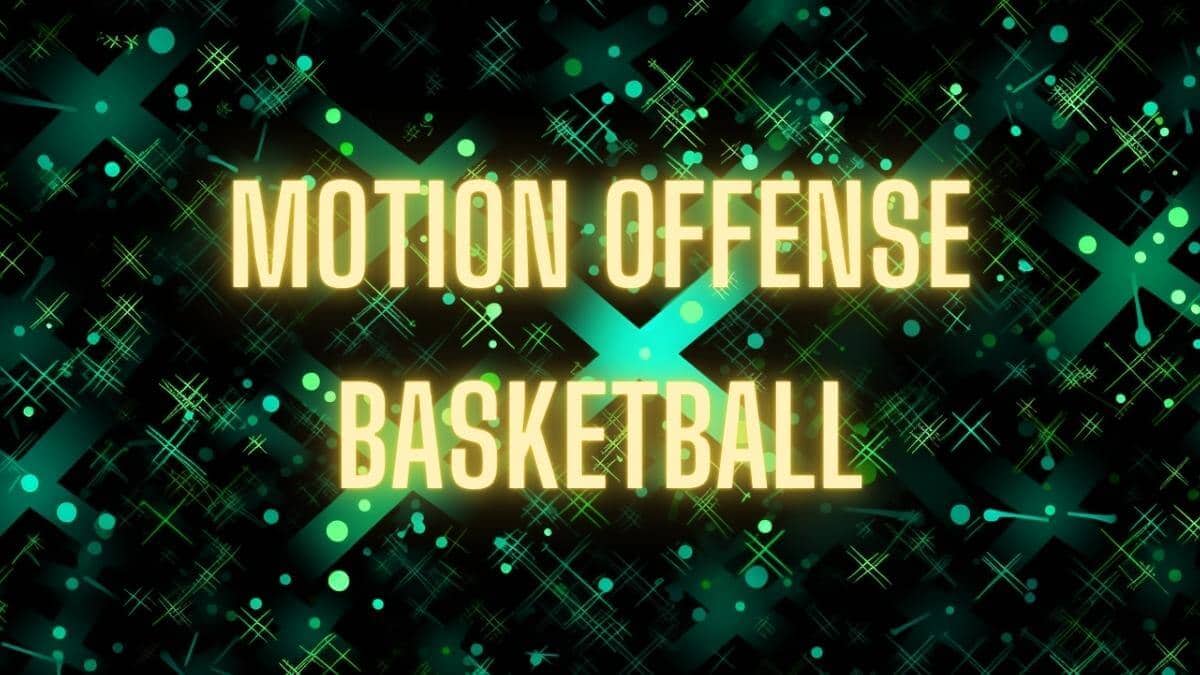When you make a purchase through links on this post, we may earn a commission through Amazon or other retailers. In this case I think it’s just one link to a book about motion offense. Learn more about our affiliate disclaimer.
Motion offense is just so wildly ubiquitous these days, it’s become crucial to have a basic understanding of how it works if you really want to understand today’s game.
In fact, this single concept of, ‘motion offense basketball’, for me personally, was a major key in my quest to see the game in a new light. As I learned the principles of motion offense and how to identify it, I was forced to stop looking at the ball and learn to see floor movement more clearly. This unlocked a whole new understanding of the game.
The defining concept behind motion offense basketball is quite simple. Players move in systematic patterns designed to create floor space and generate scoring opportunities. But that sounds like every offensive strategy ever invented in any sport played on a rectangular field.
But there are some very important details to understand here. Let’s take a look…
So what is Motion Offense Basketball exactly?
Your typical offense works to execute specific plays with specific goals in mind (i.e. get your best player to the rack). In contrast, a motion offense executes movements while encouraging players to capitalize on the opportunities that arise naturally.
So it kinda flips the traditional basketball offense on its head. We’re not scripting scoring opportunities. We’re choreographing strategic motions. And hopefully, those scoring opportunities manifest themselves.
It’s a little hippy-dippy really. Maybe that’s why I love it.
Types of Motion Offense
Over the years, as with any basketball strategy, the motion offense has been stretched and contorted to fit a wide array of teams and situations. At this point, the core idea has been explored so exhaustively that we’ve seen it branch out into countless mutations.
Here are a few of the more popular examples.
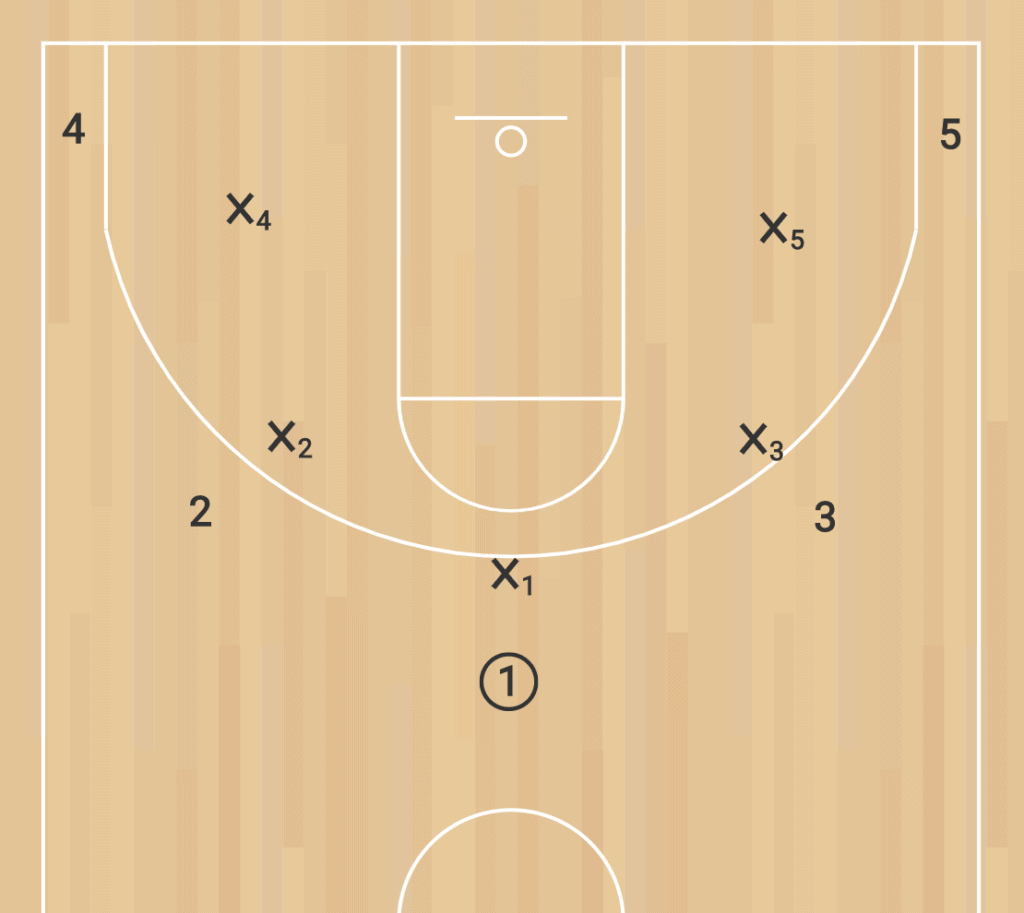
The 5-out Motion Offense
Revolving around a 5-out set, with the entire team starting out around the perimeter.
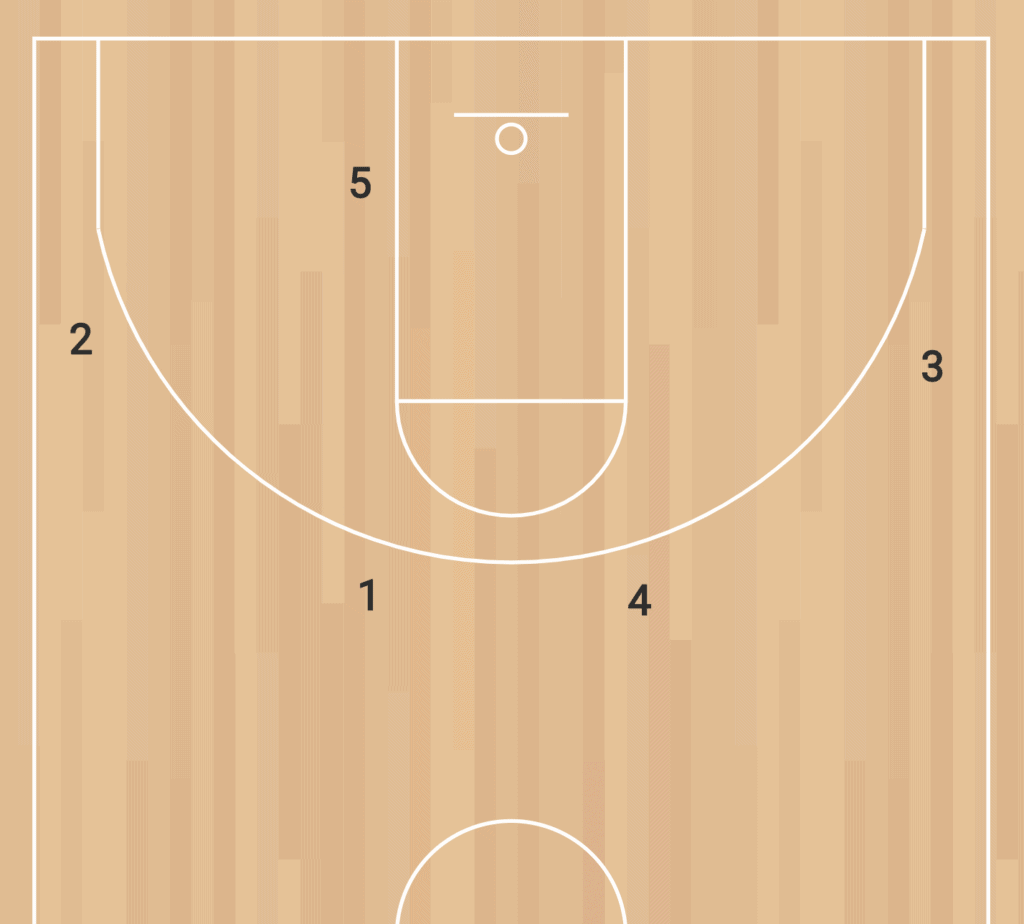
The 4-out Motion Offense
Revolving around a 4-out set, 4 around the perimeter, with a post player on the block. This is probably the most common system in basketball today.
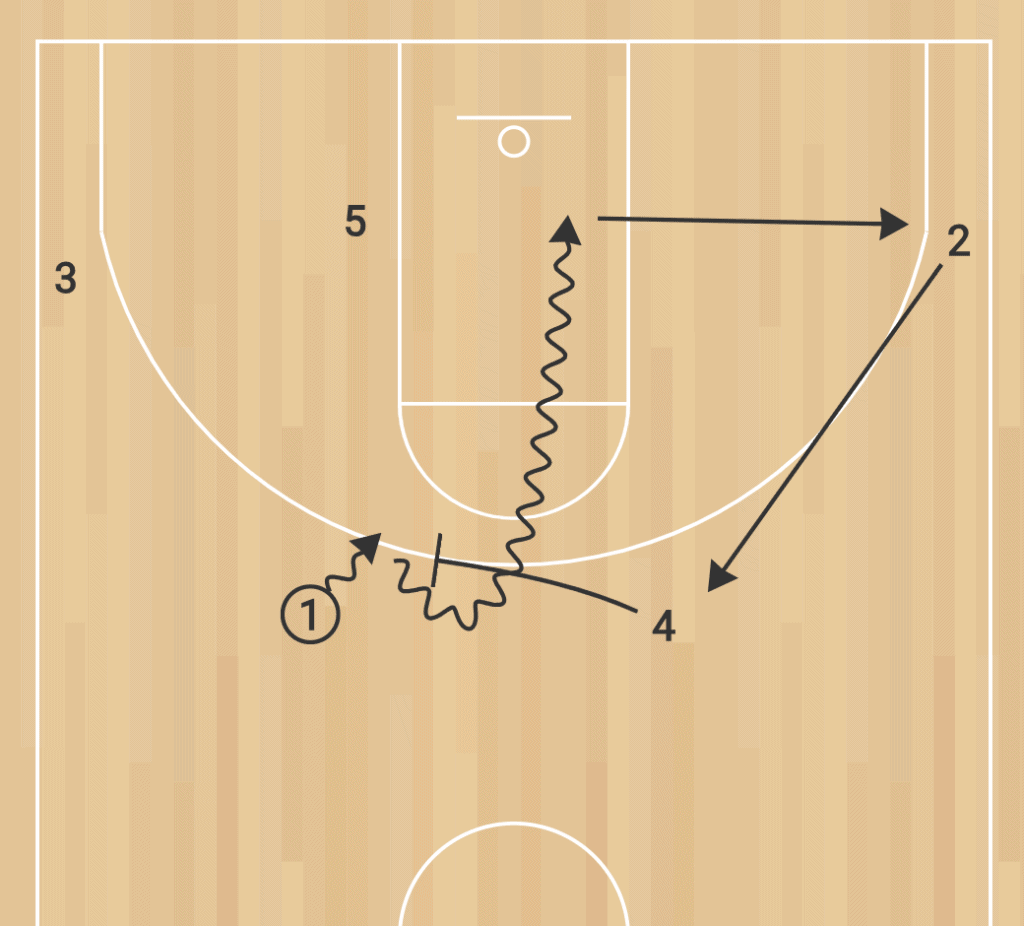
The Dribble Drive Motion Offense
Basically a 4-out, but add an obsession with dribbling into the paint. You have fewer cuts and assists here, in favor of a lot more active driving and kicking out in the face of resistance.
So, How Does the Motion Offense Work?
Unlike the Triangle or Princeton styles of offense, the driving principles behind the motion offense are relatively easy to grasp.
Typically a motion offense refers to a 4-out or 5-out positioning with an emphasis on passing and spacing. By spreading your offense, you stretch your defense away from the basket.
Lure the defense out, then attack!
With the defense spread along the perimeter, you send in cutters to probe for weakness. Specific motion systems are designed to get the team functioning on an agreed upon framework that drives this behavior.
The Advantages and Disadvantages of Motion Offense Basketball
Because this system is designed to create space on the floor and capitalize on mismatches, it’s great for a well-balanced team. That’s probably why you see it across skill levels from youth leagues to the NBA.
For young players, a motion offense can be a great way to generate a balance of scoring opportunities and get the entire team involved and having fun. But in the pros, a motion offense can create scoring opportunities spontaneously across the floor.
Just imagine 5 elite players ready to put up shots anywhere at any time. Take a look at the most recent Warriors dynasty and you see what a motion offense can accomplish.
Advantages
- Spacing the court to give defenders more ground to patrol.
- Generates open shots for the entire team.
- Allows players more time to make decisions with the ball.
- Makes it tougher to double-team, or trap.
- If penetration fails, just return to it instead of having to pass back to the point guard to reset.
Disadvantages
- Can lead to turnovers if not run correctly.
- You need a versatile post player.
- Runners may have difficulty getting open shots.
- Players all need to learn to read and react effectively.
So again, this is a strategy that is very inclusive, but it does require some skill and practice to perform it effectively and consistently. If you’re in a position where you simply want to win, and you aren’t prepared to spend months studying and refining your plays, this is probably not the strategy for you.
Executing a Motion Offense
Let’s take a look at some movements and examples. This should help you identify and understand some of the strategic markings of the motion offense as they arise in a game.
Bobb Knight’s Motion Offense Rules
You talk about a play, a ‘pick and roll’ for example and it’s easy to just draw a little diagram and it mostly makes sense. With these intricate offensive frameworks, they’re more fueled by concepts and guidelines.
When Knight first introduced his strategy, it came with some rules, most notably…
- Maintain a 25-18 foot spacing
- Limit ball possession to 2 seconds
You should already get an idea here of how this offense got its name. With your players spaced out on the floor and passing pace elevated, you’re generating a lot of movement. Interestingly, you’re also reversing the ball constantly, a hallmark of Newell’s signature strategy.
Player Roles in a Motion Offense
Motion strategies are less focused on specific roles than your typical offensive framework. As your team begins to move on the court, they should be prepared to shift between roles fluidly.
Still, there are some helpful rules we can point to.
Your post player is probably the one player who fills a traditional role. They should be hanging out on the low block. In standard fashion, there job is to take up space in the paint, fighting for position.
To clarify, let’s talk about the slots. I like to think of this like an arcade coin slot. On a classic arcade game you’ll often see a parallel set of coin slots. And these will resemble lines on the court that define the boundaries of the paint, flanking the basket.
With the 4-out offense, your point guard and your power forward will often move to slide into those slots like a coin falling into a coin slot. The way your remaining players react will be dependent on which slot gets filled.
The History of Motion Offense Basketball
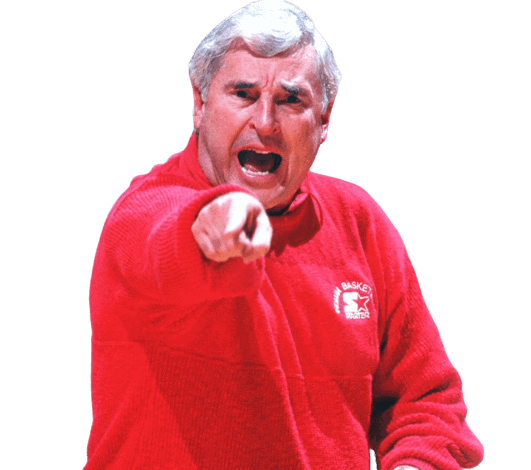
The Motion Offense has as interesting a history as any basketball framework. Most of the core motion offense systems go back to the legendary Bobby Knight.
Knight started his coaching career at West Point, coaching the Army Black Knights. He was friends with Princeton’s Pete Carill and the motion offense systems take some obvious cues from Carill’s infamous Princeton Offense. In earlier years, Knight favored a system based on Newell’s tactics, usually referred to as “reverse action“. This strategy is focused on using ball reversals to shift a defense off its footing so you can attack with your bigs.
At the time, Knight had also been paying close attention to Pete Carril’s Princeton offense as it emerged in the early 70’s. While motion offense basketball certainly bares Knight’s stamp, the influence of Iba, Carril and Newell is tough to miss.
Knight served as an assistant to Oklahoma State coach Henry Iba with the 1972 Olympic Team. Iba was known for his emphasis on passing and ball movement. The codified motion offense emerged shortly after this Olympic experience.
It was reportedly on the floor of Pete Newell’s living room that Knight initially laid out the plans for his signature offense. But motion offense goes a step further than Newell’s ‘reverse action’ on the path towards the modern basketball offense, more thoroughly dispensing with set plays in favor of a broader offensive framework. And Knight took the Hoosiers to 3 NCAA Championship titles using his Motion Offense systems during his tenure.
Now, it’s important to sprinkle in a little NBA context here. See, when Phil Jackson coached the Bulls, then the Lakers to 11 total title victories, a lot of credit was given to his chosen offensive schema, the ‘triangle offense‘.
But then came the rise of the 3-point game. In an intricate web of rules tweaks, skills evolution, and stats interpretation, teams began favoring deeper shots. As perimeter shooting took hold, it only made sense that an offensive framework that could open up 3-point opportunities would take off.
Motion offense schemas revolve around perimeter spacing. If you start at the perimeter and work through the perimeter, you’re spending a lot of time and getting a lot of quality looks, at the perimeter.
So seriously, just put on a Warriors game and see if you can even avoid seeing the motion offense at play.
And the 4-out motion systems, specifically, are as popular as ever, having played a significant role in the dominant Warriors dynasty. With some of the NBA’s most successful teams employing the strategy, the 4 out basketball offense has become a staple of modern basketball and is used by many teams in the NBA and at the collegiate level.
Takeaways
This philosophy is one of the most dominant coaching philosophies in modern basketball. It can be both fantastically intricate and beautifully improvisational.
And the history and development of the motion offense sits so squarely at the crossroads of modern basketball theory that it serves as an excellent entry into the study of basketball strategy as a whole.
The deeper intricacies of motion offense aren’t always easy to grasp. However, the basic principles can serve as the framework for even a very simple coaching philosophy. And as you build on your understanding of the motion offense, you build conveniently on your understanding of basketball as a whole.
